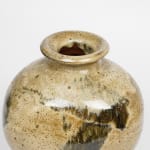Murata Gen 村田 元 Japanese, 1904-1988
H22.0 x Dia13.4 cm
Further images
-
(View a larger image of thumbnail 1
)

-
(View a larger image of thumbnail 2
)

-
(View a larger image of thumbnail 3
)

-
(View a larger image of thumbnail 4
)

-
(View a larger image of thumbnail 5
)

-
(View a larger image of thumbnail 6
)

-
(View a larger image of thumbnail 7
)

-
(View a larger image of thumbnail 8
)

-
(View a larger image of thumbnail 9
)

-
(View a larger image of thumbnail 10
)

-
(View a larger image of thumbnail 11
)

-
(View a larger image of thumbnail 12
)

-
(View a larger image of thumbnail 13
)

-
(View a larger image of thumbnail 14
)

Born as the second son of Murata Tasaburo and Retsu in 1904, Murata Gen grew up with the earth in a farming family in the Ishikawa prefecture. He studied classical painting in Kyotos until he entered the Kansai Bijutsu Gakuin (Kansai Art Academy) in 1922. However, the onset of war shattered his dreams of being a painter. His first encounter with pottery was when he visited a folk craft exhibition showcasing Mashiko wares in 1934 in Matsuzakaya, Tokyo. It was then that he had decided to relocate permanently to Mashiko in 1924, studying under Hamada Shoji. He debuted with his first solo exhibition in 1955 at Izumi Kogei craft shop, Tokyo; at last, Murata was consummated as a Mashiko potter. He displayed his honed mastery over traditional glazes such as Nuka (rice-husk), kaki-yu (persimmon), and various iron glazes that are displayed in a scrolling pattern over his functional clay wares.
Murata’s training in classical painting foregrounds his mastery over surfacescape. His functional wares employed powerful, unique glazes decoration to express scenic vistas. Like Hamada Shoji, Murata Gen chose to use only clay and glazes indigenous to Mashiko; he was a mindful Mingei practitioner that built his clay works with intention. However, he decisively departs from Hamada Shoji in choosing to use the exterior of his jars and bowls as, as it were, “canvases'' to express his deeply-held artistic intentions. Unlike the anonymous craftsmen of his contemporaries- Yanagi Soetsu, Hamada Shoji- Murata Gen worked by himself and he consistently signed his work with a ‘mu’. He sought to establish himself as an artist, blurring the lines between craftsmanship and high art.
His functional forms with high shoulders are marked with decisive facets and patch marks, while his use of rice husk glazes and multiple iron glazes depict terrestrial scenes and powerful natural phenomena. While Murata’s surfacescapes clothe his works with formally organized imagery and soulful rhetoric informed by his individualistic sight which consolidates surface, affect, and representational metaphor, one cannot ignore the materiality of his works. Signs of the object’s making- such as firing marks that signal to the Wabi-Sabi philosophies that underlie Mingei ware- attest to the wood-fired traditions of Mashiko kilns.













